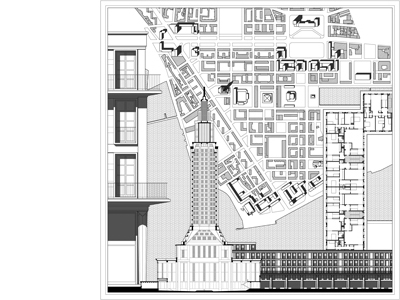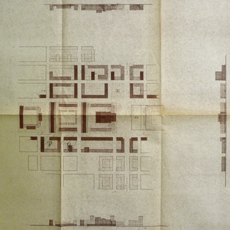You are in: Home page > Magazine Archive > The Measure of the city

Andrea Calgarotto
The Measure of the city
Auguste Perret and the new city center of Le Havre
The project of the new
center of Le Havre is, for Auguste Perret and for those architects involved in
the feat, an occasion to reflect upon the notion of measure.
The designers’ goal is that of establishing the right measure able to commensurate and coordinate the parts to the
whole. By crossing the project’s scales, this research reflects the architects’
abilities to develop a synchronic thought encompassing plan and architecture
simultaneously.
On 5 and 6 September 1944 the Royal Air Force massive bombing of the French city of Le Havre reduces the old city center to a pile of smoking rubble. The following year, in May, the Ministère de la Reconstruction et de l’Urbanisme commissions Auguste Perret to rebuild the city[1]. He is supported in this task by a group of architects of the next generation, joined together in the association called Atelier de Reconstruction du Havre. These are architects that, after having trained in the academic atelier directed by Perret himself, identify themselves as a group of ‘disciples’ cohesive with their old patron[2]. As official of the Ministry Pierre Dalloz recalls: «Perret was surrounded by a group of disciples bound to him by feelings of admiration and friendship. When, stating one of his peremptory aphorisms for the hundredth or thousandth time, everyone assented: each one recognised and respected his truth by interiorising it»[3].
Within the first few months
of work, Perret and the Atelier’s architects approached the project for the new
city center by following a synchronic thought that allowed them to conceive
both plan and architecture simultaneously. This approach aims at the aesthetic
unity of the action as a premise to a civil inhabiting.
The city is understood as a big product formalized in its entirety. The plan
takes on the structural elements of the old city structure amending them within
a new order founded on the right-angle. Three centralities – place de l’Hôtel
de Ville, Porte Océane and the Front mer sud – are positioned at the vertex of
a right triangle whose sides coincide with the main roads: the rue de Paris,
the Foch avenue and the boulevard François Ier. These elements,
together with Saint-Joseph church and place Gambetta, facing the
nineteenth-century port basin, amount to an emerging and representative system
that dialogues with the urban fabric.
The project of the new center of Le Havre provides the opportunity for the architects to reflect upon the theme of measure. They aim at finding the right measure able to discipline and coordinate the parts, thus favoring the unity of the town center. This research is carried out thanks to the geometrical device of the modular grid. The use of the modular grid supports the project by modulating the ground of the buildings as well as the open space. It helps the setting up of the plan by finding a real and conceptual order. This is a rigorous yet open scheme that permits several expressive experimentations. The modular grid is a neuter, isotropic and ‘democratic’ device, it nevertheless allows the architects to establish axes, hierarchies and centralities. It is easy, at this point, to recognize some similarities between the team involved in the project of Le Havre and the directions given by Jean-Nicolas-Louis Durand in his lessons on architecture[4].
Coherently with the
architectural research carried out by Perret in the first half of the twentieth
century, the architecture as imagined by Le Havre assumes the reinforced
concrete framework as a building and figurative device. The framework, which is
visible in the façades, undergoes an expressive research that points at
identifying the parts, organizing them over the façade plane following some hierarchic
schedules. The modular grid, while enabling footholds for pillars, generates
building frames having a uniform motion. This condition is mirrored in the
façades’ composition whose drawings are characterized by the regular rhythm of
the framework. This rhythm allows the human eye to measure the length of the
buildings as well as the surrounding space. It enables, at the same time, those
variations that characterize both the urban landscape and the individual
architectures while preserving the unity of the prospects. It is Perret himself
who eliminates any ambiguity by defining the grid as a «wide and flexible
canvas used to display the variety of infill, balconies and porticos, the free
positioning of shops among a picture»[5].
The basic grid module was initially established in 6,5 meters and later reduced
to 6,4 meters, after that it was taken to 6,24 and 6,21 meters for the chief
creations. These changes display the architects drive towards the quest for a
measure able to conciliate distributive, expressive and architectural reasons.
A module of roughly six meters, beside representing an optimum for the framework structure in reinforced concrete, permits
to place in a structural cell two rooms of approximately three meters of width,
or even a room of four meters flanked by a two meters service area.
The little changes that interested the modules over time, reveal the wish to link the module’s extension to the measures of the architectural elements. The architects direct their research towards the use of a few repeatable elements, whose measures are subordinated to a rigorous modulation. Creativity deals with combination and not with the constant invention of new solutions.
The standardization of building components, apart from supporting a rational and economic construction, represents the ideal condition to experiment those prefabrication techniques that will be effectively used during the executive stage.
During the transition from thought to execution, only some core architectural renovations will follow the initial premises. Among these interventions, Porte Océane[6] is the most fitting example of the strive towards the right measure. The intervention is a residential grand ensemble, built along the Western coasts, that offers to the architects the chance to investigate the theme of the door of the city. This is a clear metaphor of the ancient element of urban design: a drawing in the landscape that identifies the limit between the city and the ocean. The image of the threshold is conveyed by two twin towers that set up a virtual diaphragm providing the margin of the city by articulating its profile. The intervention is completed by in line elements of five or six levels that define a cruciform ground plan opened towards the ocean thanks to a narrow path leading the eye to the horizon.
The whole intervention is based upon a square mesh of 6,21 m for side. The pillars and beams frame built in reinforced concrete and left exposed, establishes an ordonnance that instills unity to the fronts. The infill amount to the succession of openings amid beams and granite and concrete panels standing full height. The module is chosen to guarantee coordination between the parts: a sub-module, equal to the ninth part of the main module, governs the width of both panels and opening thus allowing different rhythms and combinations among them. The use of the same infill prevail near the city in order to stress the unity of the public space. Near the ocean, the extremely articulated rhythms of the infill remind of the regularity of the framework.
The serial nature of the intervention allows the architects to experiment two different building techniques. In the southern portion the bearing structures are made by in loco poured concrete and completed by infill realized on-site; in the northern portion, a system of in fabric prefabrication of the structural and infill elements is employed.
As this essay wants to outline, the use of the modular grid, reflecting the drive towards the right measure, is an instrument that tries to crate a link – both real and conceptual – amid the scales of the project. The modular grid proceeds in line with the scalar synchronicity that represents the emerging and characteristic element of the approach followed in the project of the new city center of Le Havre. The reading of the facts as proposed in this essay does not want to justify the global outcomes of the city center starting only from the notion of measure. This essay wants to touch upon one of the aspects that dialectically coexist in the genesis process of the project; it also displays some elements of transmissibility within the contemporaneous project.
[1] For a description of historical events see Martine Liotard, Le Havre 1930-2006, la renaissance ou l’irruption du moderne, Picard, Paris 2007.
[2] On Perret’s ‘school’ see Joseph Abram, Perret et l’École du classicisme structurel (1910-1960), search report, École d’architecture de Nancy, Nancy 1985.
[3] Pierre Dalloz, Auguste Perret e la ricostruzione di Le Havre, in «Casabella-Continuità», n. 215, 1957, p. 52.
[4] Jean-Nicolas-Louis Durand, Préçis des leçons d’architecture données à l’École Polytechnique, 2 voll., Paris, 1803-1805.
[5] Auguste Perret and André Le Donné, Avant-propos, in «Annales de l’Institut Tecnique du Bâtiment et des Travaux Publics», n. 65, 1953, p. 438.
[6] The project is carried out by two teams of architects guided by just as many members of the Atelier de Reconstruction du Havre: Jacques Poirrier for the northern part, André Hermant for the southern part. In this occasion Auguste Perret solely supervises the projects.
Translation by Fiammetta Calzavara.















